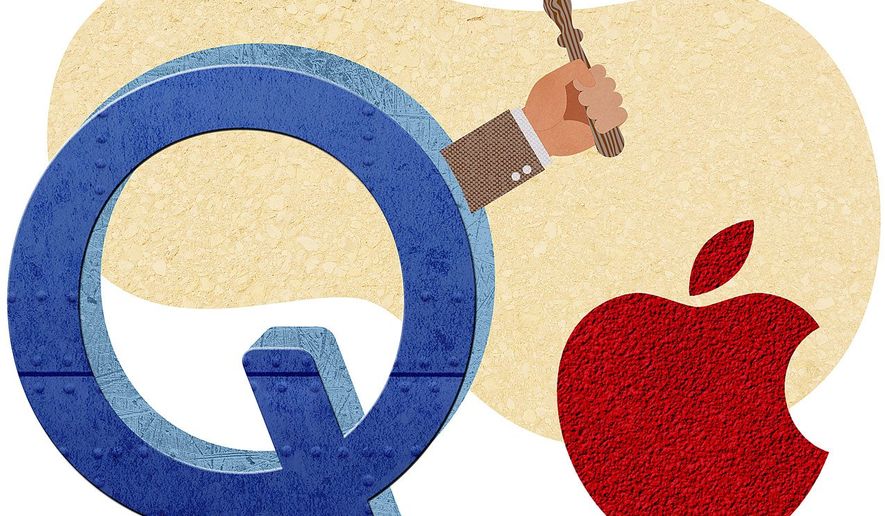OPINION:
Earlier this week Apple was found to infringe a hardware patent of Qualcomm’s. The administrative law judge at the International Trade Commission indicated that she would be recommending an import ban on the infringing products — the necessary remedy for addressing such infringement.
This finding of infringement by Judge Mary Joan McNamara and recommendation of an exclusion order gives Qualcomm its latest win over the Silicon Valley behemoth — and a win for patent rights.
This decision follows a unanimous federal jury decision to award wireless technology leader Qualcomm monetary damages in a patent infringement lawsuit against Apple. Courts in Germany and China also already issued injunctions stopping Apple from continuing to sell certain models of the iPhone containing patent-infringing components that copy Qualcomm’s inventions.
In a related case that stems from Apple’s global effort to encourage regulatory attacks on Qualcomm, Japan’s Fair Trade Commission has reversed a 2010 order that said Qualcomm’s licensing model violated Japanese antimonopoly law.
Until the recent jury verdict and this week’s recommendation of an import ban, Qualcomm has in a sense gotten more justice in the global leader’s IP battle with Apple from foreign courts with the injunctions than from U.S. adjudicators.
American innovation leadership has long rested on our strong system of protecting property rights — including intellectual property, like patents. Critical to this property rights system is the ability of inventors to defend those rights. Some recent legal decisions have sent a positive — but incomplete — signal.
This week’s International Trade Commission determination is a welcome return to the ITC’s practice of issuing import bans when companies engage in unfair trade practices (such as Apple’s infringement of Qualcomm’s inventions). The ITC’s role involves protecting American industry from unfair competitive trade acts. Such unfair competition includes importing foreign-made products that infringe U.S. patents.
Apple’s infringing products are subject to such bans as it imports iPhones and its other products because it doesn’t manufacture its products in the United States. They’re made in China and support Chinese manufacturing jobs.
Judge McNamara’s finding of infringement and the recommendation of an exclusion order, offer a sharp contrast to a disturbing decision last year in a different Qualcomm patent dispute. In that case, a now-retired administrative law judge found that Apple had infringed Qualcomm’s patent, yet declined to recommend the sole, near-automatic remedy of an exclusion order. Finding a company has infringed a patent but then declining to impose the one actual remedy undermines property rights and the legitimacy of the ITC. While the full ITC has now overturned that finding of infringement — which is subject to appeal — it was a dangerous precedent nonetheless and it is good to see Judge McNamara did not follow the prior administrative law judge’s lead.
What’s at stake here overshadows litigation between companies. Rather, this fight strikes at the heart of fundamental principles of property rights, the rule of law and due process. That’s essentially the ITC’s job and it is important that the ITC accept Judge McNamara’s recommendation that Apple must not be allowed to continue to infringe Qualcomm’s inventions.
On one side, you have the innovator that invested in research and development to create 130,000 patented inventions over three decades — that is, Qualcomm created new property that didn’t previously exist. On the other side, you have the implementer, Apple, which primarily aggregates other firms’ technology as the guts of its products, ultimately deciding to use stolen IP in its devices.
Think of a landowner working and improving her property and a trespasser stealing the produce and selling it as his own. Similarly, patent infringement jeopardizes the IP owner’s ability to flourish because IP secures exclusivity.
Rules-based protection of intellectual property rights ensures fairness and justice. Such property rights-based rule of law serves the public interest by enabling U.S. R&D leaders to thrive by leading innovation in their respective fields.
Innovation improves people’s lives and creates new wealth and new jobs. In the national economic context, innovation grows our economic pie, contributing to our nation’s industrial competitiveness and funding national security. Innovation even spurs new industries.
Strong, swift justice for IP owners, including monetary awards, injunctions and barring patent-infringing imports, promotes R&D and commercialization of IP-based inventions. For Qualcomm, such justice ensures that the cellular technology leader keeps its vital edge in 5G.
Without Qualcomm’s cellular infrastructure, there’d be no app economy, an iPhone would be an iPod, and digital disruptors would be disrupted and begging for retail clerk jobs.
Qualcomm is the sole U.S. innovator vying for 5G leadership against Chinese government-subsidized champion Huawai. Qualcomm’s patent licensing revenues finance its R&D and is vital to its technological and cybersecurity prowess. The intelligence and security community places well-earned trust in Qualcomm and the integrity of its technology.
In short, Qualcomm’s victories for patent rights in the federal court and the recommendation of an exclusion order indisputably benefit America, and its 5G leadership.
It is important that the ITC continue to use its available remedy to let Apple and all implementers know that IP theft will not be tolerated in the U.S. Property rights must be protected by every available tool, including the ITC, or we will fall behind as a nation of inventors.
• James Edwards is executive director of Conservatives for Property Rights and patent policy adviser to Eagle Forum Education & Legal Defense Fund. The views expressed are his own.




Please read our comment policy before commenting.